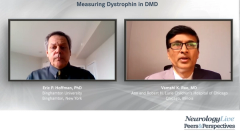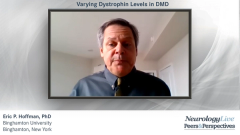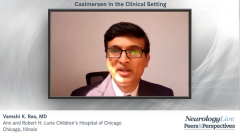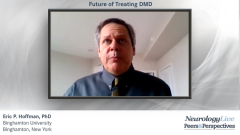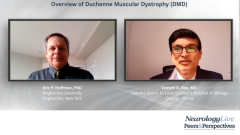
Use of Steroids in Combination With Other Treatments in DMD
A discussion with parents on treatment options in Duchenne muscular dystrophy as well as the benefit of using steroids combined with other therapies.
Episodes in this series

Vamshi K. Rao, MD: One of the things I always think about and talk to parents about is trying to tackle this very progressive condition from different angles. There are therapies targeting different parts of the mechanism of progression or destruction, as you alluded to. Your analogy about having a bird in hand, in terms of having available therapy right now, could maybe alter the progression positively. Maybe down the line, if you’re not using a therapy that would be banned in the future or barred in some way, we could always come back with another mechanism. Could you envision combinations in the future with steroids somewhat being the cornerstone and the other therapies adding on top of one another?
Eric P. Hoffman, PhD: Absolutely. Most of the people in this field probably imagine that the therapies that will really slow or stop the progression of this disease are going to be combination therapies. If we use gene therapy as an example, that’s still semifunctional dystrophin, and the exon skipping is still Becker dystrophin. All those conditions are still progressive disorders. With Becker muscular dystrophy, most patients lose ambulation. It’s just slowed. We need therapies that attack different parts until the we can deliver lots of full-length dystrophin, but there are currently no therapies even envisioning doing that. It’s so large and hard to work with. No clinical trials have attempted to introduce full-length dystrophin. I don’t know of any clinical programs even trying. If we’re stuck with this semifunctional dystrophin, we still need supportive care and supportive therapeutics, as you said.
We’ve learned a lot about the progression. We know that dystrophin is missing in fetal life. The first events we see in the pathological events in the patient muscle is right after birth. The serum creatine kinase goes through the roof. The muscle is leaking. It’s disturbed, and with that comes an innate immunity, NF-kappaB pathways. As you pointed out, those corticosteroids are the prototypical sledgehammer to shut down NF-kappaB or the immunity. That’s why they’re used and prescribed in so many inflammatory conditions. As you noted, corticosteroids are considered standard of care for Duchenne [muscular dystrophy]. Unfortunately, they come with a lot of adverse effects, like stunting of growth, mood disturbance, cushingoid, bone fragility—the list goes on. That can detract from patient quality of life.
With any therapy, you have to balance efficacy and safety and try to find a therapeutic window. Because of that, although it might make sense to prescribe corticosteroids from birth, current feelings are that the risk benefit is not worthwhile, so most physicians wait until children are more symptomatic. Although there are lots of trials in younger patients down to infants, as with Anne Connolly and others. Maybe you’ve participated in some of those. It seems to show benefit.
We have developed an alternative modification of the steroid backbone called vamorolone, which is no longer a corticosteroid, but it retains that NF-kappaB anti-inflammatory activity. We’re in phase 3 trials with that. So far, children have not shown the growth stunting or some of the other adverse effects of corticosteroids. That can shift your balance of efficacy and safety and maybe enable earlier dosing to do what you suggested: a multidrug therapy that will really hit the disease at multiple levels and slow it down.
Vamshi K. Rao, MD: I’m glad you mentioned vamorolone, because you’re the thought leader about steroids and alternative steroids, because I was definitely going to bring that up.
I thank all of you for watching this Neurology Live® Peers & Perspectives®. If you enjoyed the content, please subscribe to our newsletters to receive upcoming programs and other great content in your in-box. Thank you.
Transcript Edited for Clarity
Newsletter
Keep your finger on the pulse of neurology—subscribe to NeurologyLive for expert interviews, new data, and breakthrough treatment updates.


